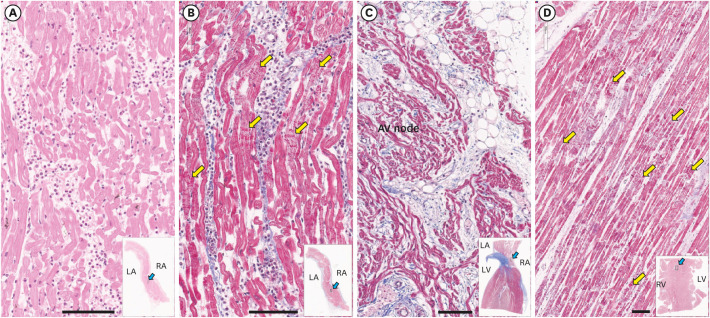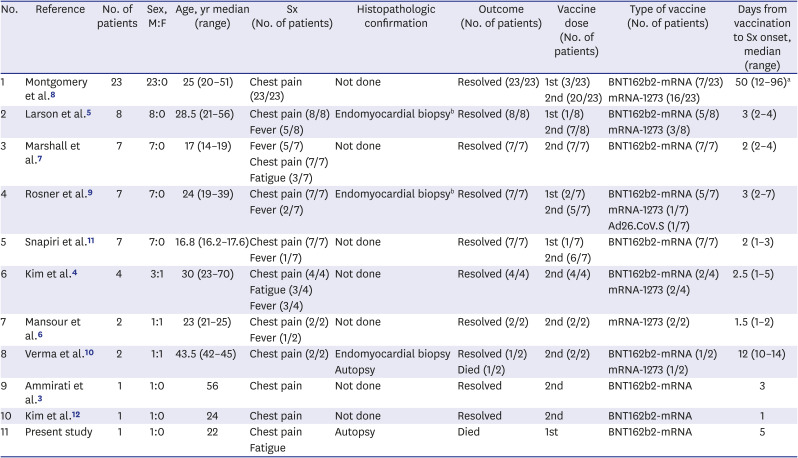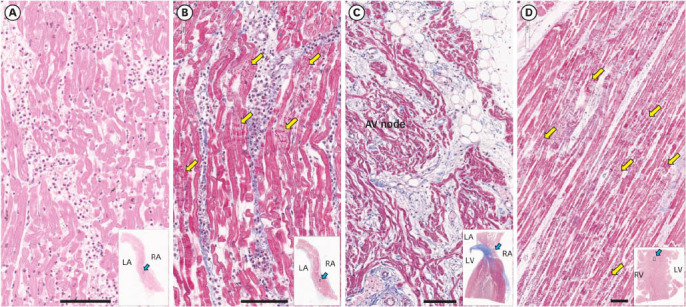1. Oliver SE, Gargano JW, Marin M, Wallace M, Curran KG, Chamberland M, et al. The advisory committee on immunization practices' interim recommendation for use of Pfizer-BioNTech COVID-19 vaccine - United States, December 2020. MMWR Morb Mortal Wkly Rep. 2020; 69(50):1922–1924. PMID:
33332292.

2. Oliver SE, Gargano JW, Marin M, Wallace M, Curran KG, Chamberland M, et al. The advisory committee on immunization practices' interim recommendation for use of Moderna COVID-19 vaccine - United States, December 2020. MMWR Morb Mortal Wkly Rep. 2021; 69(5152):1653–1656. PMID:
33382675.

3. Ammirati E, Cavalotti C, Milazzo A, Pedrotti P, Soriano F, Schroeder JW, et al. Temporal relation between second dose BNT162b2 mRNA Covid-19 vaccine and cardiac involvement in a patient with previous SARS-COV-2 infection. Int J Cardiol Heart Vasc. Forthcoming. 2021; DOI:
10.1016/j.ijcha.2021.100778.

4. Kim HW, Jenista ER, Wendell DC, Azevedo CF, Campbell MJ, Darty SN, et al. Patients with acute myocarditis following mRNA COVID-19 vaccination. JAMA Cardiol. Forthcoming. 2021; DOI:
10.1001/jamacardio.2021.2828.

5. Larson KF, Ammirati E, Adler ED, Cooper LT Jr, Hong KN, Saponara G, et al. Myocarditis after BNT162b2 and mRNA-1273 vaccination. Circulation. 2021; 144(6):506–508. PMID:
34133884.

6. Mansour J, Short RG, Bhalla S, Woodard PK, Verma A, Robinson X, et al. Acute myocarditis after a second dose of the mRNA COVID-19 vaccine: a report of two cases. Clin Imaging. 2021; 78:247–249. PMID:
34166884.

7. Marshall M, Ferguson ID, Lewis P, Jaggi P, Gagliardo C, Collins JS, et al. Symptomatic acute myocarditis in seven adolescents following Pfizer-BioNTech COVID-19 vaccination. Pediatrics. 2021; 148(3):e2021052478. PMID:
34088762.

8. Montgomery J, Ryan M, Engler R, Hoffman D, McClenathan B, Collins L, et al. Myocarditis following immunization with mRNA COVID-19 vaccines in members of the US military. JAMA Cardiol. Forthcoming. 2021; DOI:
10.1001/jamacardio.2021.2833.

9. Rosner CM, Genovese L, Tehrani BN, Atkins M, Bakhshi H, Chaudhri S, et al. Myocarditis temporally associated with COVID-19 vaccination. Circulation. 2021; 144(6):502–505. PMID:
34133885.

10. Verma AK, Lavine KJ, Lin CY. Myocarditis after Covid-19 mRNA vaccination. N Engl J Med. 2021; 385(14):1332–1334. PMID:
34407340.

11. Snapiri O, Rosenberg Danziger C, Shirman N, Weissbach A, Lowenthal A, Ayalon I, et al. Transient cardiac injury in adolescents receiving the BNT162b2 mRNA COVID-19 vaccine. Pediatr Infect Dis J. 2021; 40(10):e360–e363. PMID:
34077949.

12. Kim IC, Kim H, Lee HJ, Kim JY, Kim JY. Cardiac imaging of acute myocarditis following COVID-19 mRNA vaccination. J Korean Med Sci. 2021; 36(2):e229. PMID:
34402228.

13. Aretz HT, Billingham ME, Edwards WD, Factor SM, Fallon JT, Fenoglio JJ Jr, et al. Myocarditis. A histopathologic definition and classification. Am J Cardiovasc Pathol. 1987; 1(1):3–14. PMID:
3455232.
14. Leone O, Pieroni M, Rapezzi C, Olivotto I. The spectrum of myocarditis: from pathology to the clinics. Virchows Arch. 2019; 475(3):279–301. PMID:
31297595.

15. Tse R, Garland J, Kesha K, Triggs Y, Modahl L, Milne D, et al. A rare case of isolated atrial myocarditis causing death with no post mortem computed tomography scan correlation. Am J Forensic Med Pathol. 2018; 39(2):123–125. PMID:
29120873.

16. Duffy M, O'Connor K, Milne D, Ondruschka B, Tse R, Garland J. Isolated atrial neutrophilic myocarditis: a rare cause of death and potential “Blind Spot” for postmortem computed tomography and postmortem examination. Am J Forensic Med Pathol. Forthcoming. 2021; DOI:
10.1097/PAF.0000000000000684.
17. Halushka MK, Vander Heide RS. Myocarditis is rare in COVID-19 autopsies: cardiovascular findings across 277 postmortem examinations. Cardiovasc Pathol. 2021; 50:107300. PMID:
33132119.

18. Jum'ah H, Loeffler A, Tomashefski JF Jr. Histopathological findings in the hearts of COVID-19 autopsies: a letter to cardiovascular pathology journal editor in response to Halushka et al. 2020. Cardiovasc Pathol. 2021; 52:107333. PMID:
33741530.
19. Fox SE, Akmatbekov A, Harbert JL, Li G, Quincy Brown J, Vander Heide RS. Pulmonary and cardiac pathology in African American patients with COVID-19: an autopsy series from New Orleans. Lancet Respir Med. 2020; 8(7):681–686. PMID:
32473124.

20. Baroldi G, Mittleman RE, Parolini M, Silver MD, Fineschi V. Myocardial contraction bands. Definition, quantification and significance in forensic pathology. Int J Legal Med. 2001; 115(3):142–151. PMID:
11775016.







 PDF
PDF Citation
Citation Print
Print




 XML Download
XML Download